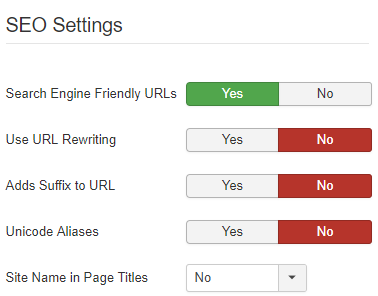Today we will study how to enable SEF (Search Engine Friendly) URLs. First, let’s define the role of SEF URLs.
Search engine friendly (SEF), human-readable or clean URLs are URLs that make sense to both humans and search engines because they explain the path to the particular page they point to.
Since version 1.5, Joomla! is capable of creating and parsing URLs in any format, including SEF URLs. This does not depend on URL rewriting executed by the web server, so it works even if Joomla! runs a server other than Apache with the mod_rewrite module. The SEF URLs follow a certain fixed pattern, but the user can define a short descriptive text (alias) for each segment of the URL.
Search Engine Friendly URLs have to be enabled if you want to have the website better indexed by search engines and make it easier to remember site URLs.
To enable SEF URLs for your Joomla website, follow the steps below:
- Log into your Joomla admin panel and navigate to System -> Global Configuration menu
- You will see the following options under Site tab:

- Search Engine Friendly URLs – select whether the URLs are optimized for search engines or not. If you set it to Yes, the URLs will be changed to something similar to http://domain.com/index.php/blog
- Use URL rewriting option allows you to remove /index.php part from the URL. This option is available for Apache or IIS 7 only.
- Adds Suffix to URL – if Yes, the system will add a suffix to the URL based on the document type. ‘.html’ will be added at the end of the URL. E.g. http://domain.com/blog.html
- Unicode Aliases option allows you to select between the transliteration or Unicode aliases. Transliteration is selected by default.
- Include Site Name in Page Titles setting allows you to define whether your site title includes your Site Name or not. You can set it to any of the following settings: No/Before/After
- Select needed options and save the changes.
Please, note, that if you use an Apache server you need to make sure mod_rewrite module is installed and enabled on your hosting account.
Connect to your FTP server, rename the htaccess.txt file to .htaccess. If you use IIS 7 server, make sure IIS URL Rewrite Module is enabled for your hosting account.
Rename web.config.txt file to web.config before activating the ‘Use URL rewriting’ option. The URLs will change to something similar to http://domain.com/blog
We hope this article helped you to learn how to enable SEF URLs easily.











